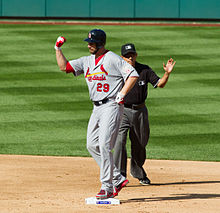Chris Carpenter
[8] His early success continued throughout the season as he finished with a 2.56 earned run average (ERA) with 80 strikeouts (SO), 39 bases on balls (BB) and 76 hits allowed in 84+2⁄3 innings pitched (IP).
[11] He spent the entire season there, starting 28 games, pitching 171+1⁄3 innings, allowing 161 hits, 75 earned runs, and 91 walks while striking out 150 and compiling a 1.61 strikeout-to-walk ratio.
[12] Carpenter made his Major League Baseball (MLB) debut as a starter against the Minnesota Twins on May 12, 1997, completing three innings with eight hits, seven runs, and three walks while striking out five in a 12–2 loss.
That stage included his total relief work for the season, where he made nine appearances and completed 22+2⁄3 innings, allowing a 2.38 ERA and carrying a 1–0 record.
Carpenter's finish to the season proved superior to the beginning; in eight of his final ten starts, he was charged three earned runs or fewer.
Carpenter's August ERA was 6.46 and his season ended early on September 16 when Dr. James Andrews performed surgery to remove a bone spur.
Opposing Red Sox ace Pedro Martínez—the eventual Cy Young Award winner that year—in Boston on May 23, Carpenter emerged victorious in a 3–2 decision.
In a September 16 contest against the Chicago White Sox, a ball hit off the bat of José Valentín struck him in the face, forcing him from the game.
His 11 victories tied him with Esteban Loaiza and Paul Quantrill for the team high, and he was considered one of the Blue Jays' starters of the future along with Roy Halladay.
The Blue Jays named Carpenter their opening day starter for the first time in his career on April 1, 2002, at Fenway Park against the Red Sox.
After the season—and plagues of injuries and control issues that did not fully resolve over his career in the Toronto organization—the Blue Jays removed him from the 40-man roster and offered him a minor league, incentive-based deal.
He matched up against the Houston Astros and former Blue Jays rotation mate Roger Clemens on May 28, pitching eight scoreless innings while allowing just two hits.
[29][30] The nerve problem caused Carpenter to miss the postseason, including what would have been his first World Series appearance,[28] which the Boston Red Sox won.
[46] For the second consecutive season, the Cardinals repeated as Central division champions, and won at least 100 games with the best record in the National League.
[37] Finally healthy for an entire season, Carpenter pitched in the postseason for the first time in his career, debuting on October 4 against the Padres in Game 1 of the National League Division Series (NLDS).
[59] Debuting in Coors Field on July 25 against the Rockies, Carpenter combined with Randy Flores and Jason Isringhausen for the Cardinals' first-ever shutout win (1–0) in Denver.
[63] He became the third member of the St. Louis Cardinals pitching staff to gain his 100th career win in 2006, joining Jeff Suppan and Mark Mulder in a September 16 matchup against the San Francisco Giants.
Per the Elias Sports Bureau, that performance made him the first pitcher in Cardinals history to pitch eight innings and allow no walks and no more than three hits in a World Series contest.
[73] At one point in 2008, he began experiencing numbness in his pitching forearm, which lingered for the rest of his career, and transformed into weakness, intermittently shifting from his arm to his hands, neck, and facial muscles.
[95] Early in the 2010 season, Carpenter began to experience increased symptoms related to the prior weakness and numbness in his pitching arm that was concentrated mainly in his shoulder.
He gained relief through multiple remedies that included deep massage and muscle release that chiropractor Dr. Clayton Skaggs performed.
While pinned against a backstop, Reds' starting pitcher Johnny Cueto kicked wildly at several Cardinals, hitting Carpenter and catcher Jason LaRue several times.
At the close of the 2011 regular season, the Cardinals called on Carpenter to consummate what St. Louis Post-Dispatch sportswriter Bernie Miklasz termed an "improbable comeback".
On Friday, October 7, Carpenter started for the second time in the series for the finale in Philadelphia, matching up against former Blue Jays teammate and friend Roy Halladay.
Initial recovery time was estimated at six months, meaning he would miss the remainder of the 2012 season and be ready for spring training the following February.
[122] Like teammate Adam Wainwright, Carpenter's repertoire consisted mostly of sinkers (90–94 mph), cutters (87–90), and curveballs (74–77), with occasional four-seam fastballs and a changeup used against left-handed hitters.
"[127] As a pitcher who missed considerable playing time due to injury, Carpenter won three major Comeback Player of the Year awards in two separate seasons.
Chairman William DeWitt, Jr., remarked "Chris will always be remembered as the leader of the pitching staff during one of the great eras of Cardinals baseball.
[132] The Cardinals announced on April 29, 2016, that Carpenter was voted by fans into the franchise Hall of Fame, with the enshrinement taking place on August 27, 2016.
[136] In the 2011–12 offseason, Carpenter and Roy Halladay were fishing in the Amazon River with fellow pitcher B. J. Ryan and professional sport fisherman Skeet Reese when they encountered a wounded man who was stranded.


